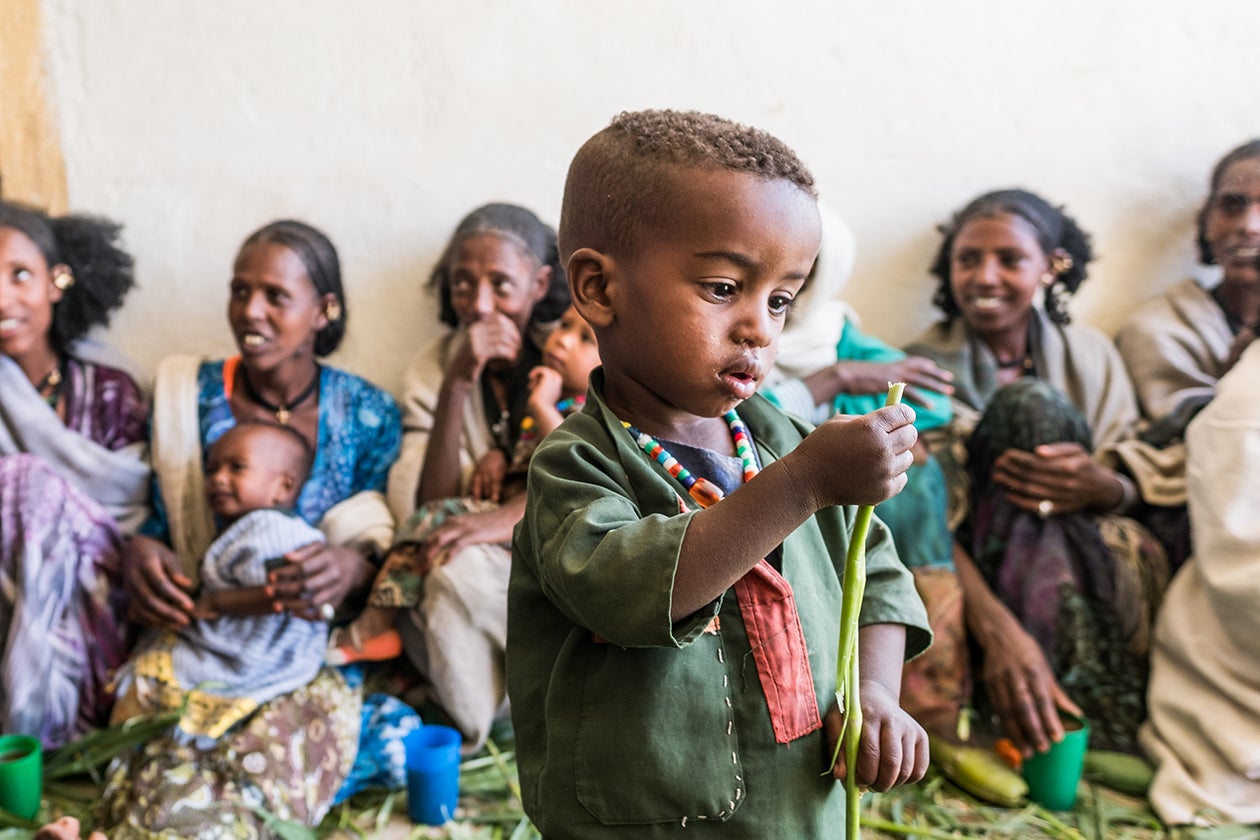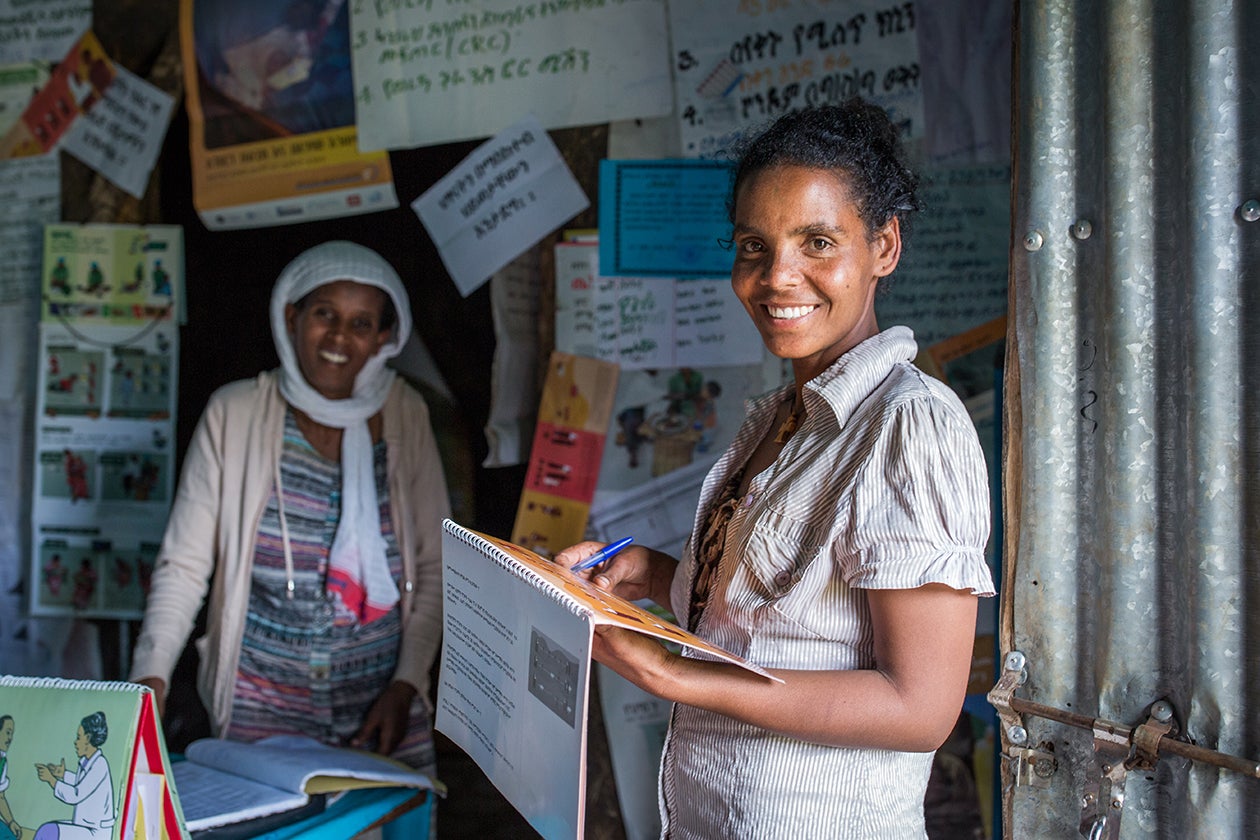Key Points
Ethiopia’s creation of a strong, widespread, and comprehensive community health program was particularly valuable in reducing mortality among children under age five (under-five mortality or U5M), because it could account for the country’s considerable size, challenging terrain, and large rural and pastoralist populations.
The country made effective use of donor and partner resources, including both financial and technical assistance. The Ethiopian government generally succeeded in coordinating these varied resources in alignment with clearly stated national priorities.
Ethiopia placed a high priority on strengthening health systems and infrastructure, including improving facilities and developing data systems.
Strengthening the Primary Health Care System and Infrastructure
During the study period (2000–2015), the government worked to advance the construction of health posts and health centers throughout the country, and to convert existing health centers to primary hospitals in order to increase access to comprehensive primary health care.
In 1994, the public health sector included 82 hospitals, 288 health centers, and 1,311 health posts. By 2014, there were 111 hospitals, 2,689 health centers, and 14,416 health posts. In addition, the government expanded access to health facilities through such measures as the creation of free ambulance services for deliveries and other emergencies.
IMPROVEMENTS IN NUMBER OF HEALTH FACILITIES, 1994-2014

In addition to expanding facilities and infrastructure, Ethiopia’s Federal Ministry of Health (FMOH) collaborated with the Ministry of Education to strengthen the health workforce. The government implemented new training programs for physicians, midwives, and other health professionals – and improved programs that were already in place.
The FMOH also created new cadres of workers, particularly health extension workers (HEWs) and integrated emergency surgical officers, to alleviate the national health personnel shortage and increase access to care.
The FMOH continuously increased the role and responsibility of HEWs (whose original portfolio was generally limited to health promotion activities) to provide direct care delivery duties relevant to reducing U5M. For their part, the integrated emergency surgical officers served as non-physician surgeons capable of performing relatively straightforward procedures, especially cesarean sections.
Creating a Strong, Comprehensive Community Health System
The creation of the national Health Extension Program was fundamental to the establishment of an effective national community health system. Key informants repeatedly singled out the Health Extension Program as crucial to the country’s success in reducing U5M. One FMOH official referred to it as “the major umbrella” covering Ethiopia’s child health initiatives.
Under the Health Extension Program, HEWs played an instrumental part in carrying out U5M interventions, making health services more accessible to many communities that previously had little or no access to them.
The Health Extension Program provided preventive services such as immunizations and distribution of insecticide-treated malaria bed nets. As it grew, it also offered curative services, particularly in rural areas. The Health Extension Program soon became a widespread national program that reached many rural and pastoralist areas traditionally underserved by static health facilities. It evolved into a platform for introducing new programs such as Integrated Community Case Management, and for delivering services typically provided in health centers and larger facilities, including immunizations and antenatal care.

Even with its many contributions to reducing U5M, the Health Extension Program has run into some formidable challenges, notably a lack of awareness and use of services in many communities – as well as turnover among the health workers themselves. See the article within this narrative for more information.
Ensuring the Availability of Donor and Partner Resources and Effective Government Coordination
Ethiopia’s campaign to reduce U5M benefited immensely from a strong influx of donor and partner resources over the study period. Multilateral organizations such as Gavi and the Global Fund to Fight AIDS, Tuberculosis and Malaria invested heavily in Ethiopia’s U5M initiatives. In 2000, external funding made up only 15 percent of total health spending in Ethiopia, and increased to 28 percent by 2015.
In addition to financial resources, donors and partners provided the FMOH with technical and human resources that advanced U5M interventions, often beginning in the exploration and preparation phases. The technical working groups that shaped the early stages of interventions frequently included international collaborators.
Implementing partners often supported preparation activities such as the adaptation of international guidelines to fit local contexts, or the development and execution of pilot studies. During implementation, these partners typically had a significant role in training and scaling up programs, as in the rollout of facility-based Integrated Management of Childhood Illness.
Coordination of these partners and their resources (whether financial or operational) was extremely important, and the government took it very seriously. The FMOH adopted a “one plan, one budget, and one report” approach, under which all parties involved in the health sector must align their activities with the priorities of the government.
This allowed the ministry to guide resources efficiently, including the resources from international donors and partners. Rather than resulting in parallel programs, external resources in Ethiopia were leveraged to support government-led initiatives.
Commitment to Data Collection, Pilot Testing, and Rapid Scale-Up of Interventions

In its efforts to reduce U5M, Ethiopia made heavy use of data to assess disease burdens and set priorities. This was often followed by small-scale implementation and pilot studies, followed by rapid national expansion.
Ethiopia has a long history of valuing data and using it for planning, prioritization, and implementation of new initiatives. Several national surveys are conducted in Ethiopia and have been used to guide policy and planning, including the Demographic Health Survey, Ethiopia Service Provision Assessment, Service Availability and Readiness Assessment, and Malaria Indicator Survey.
In addition to these surveys, the FMOH uses data from the Health Management Information System and local studies to inform many activities, such as setting national priorities, determining appropriateness of specific interventions, and planning the implementation of those interventions.
During its preparations to introduce the meningococcal meningitis vaccine, the FMOH used risk assessment mapping to plan phased immunization campaigns. This use of risk mapping allowed the FMOH to prioritize the highest-risk areas prior to implementation of campaigns across the entire country.
Pilot testing was used to determine feasibility and inform national scale-up for many interventions, but Ethiopia also recognized the importance of rapid introduction and expansion. It was therefore willing to forego pilot tests for those interventions – such as other vaccines – that did not require significant context-specific adaptation, had a history of acceptability, or were substantiated by strong global evidence.
For example, Ethiopia opted for a rapid national introduction of the meningitis A vaccine based on existing data, drawing upon available risk-mapping data to inform national rollout.
